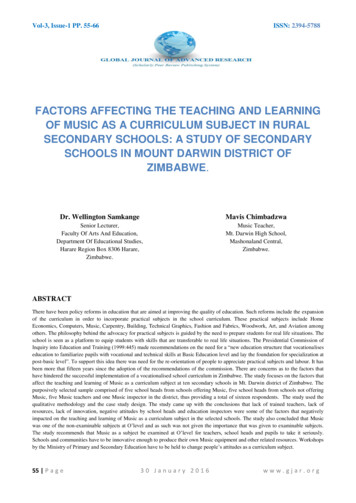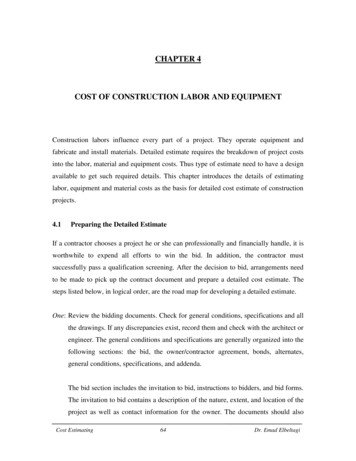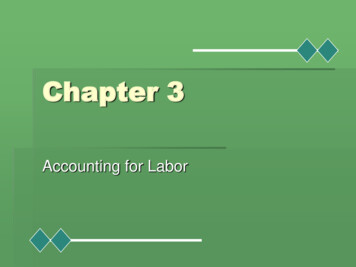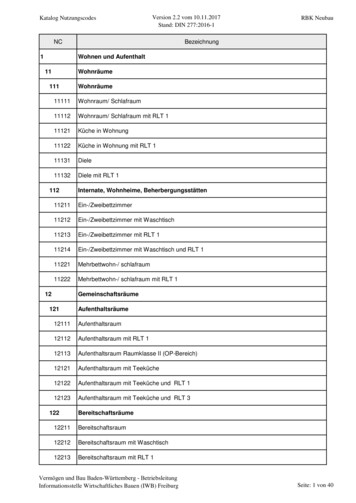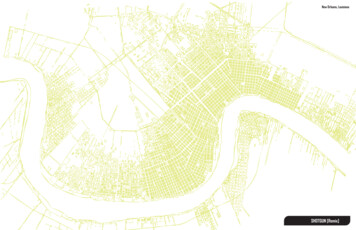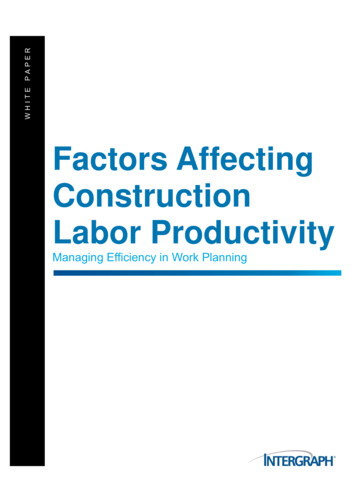
Transcription
WHITE PAPERFactors AffectingConstructionLabor ProductivityManaging Efficiency in Work Planning
Factors Affecting Construction Labor ProductivityContents1. Introduction . 12. Labor Impacts on Construction Planning. 23. Unique Projects . 34. Methods of Measuring Inefficiency . 45. Contractor Productivity Loss Claims. 56. Factors Affecting Labor Productivity . 66.1 Labor Factors. 66.2 Severity of Inefficiencies . 96.2 Severity of Extended Inefficiencies . 97. Manage Labor Factors with Planning Tools . 117.1 Selectable Labor Factors. 117.2 Filter to Find Material and Equipment Availability . 117.3 Use Filtering to Visualize Congestion . 127.4 Visualize and Eliminate Need for Labor Factors . 137.5 Manage Constraints . 148. Enhancing Construction Planning . 15i
Factors Affecting Construction Labor Productivity1. IntroductionThe measure of the rate at which work is performed is called “productivity”. It is a ratio of productionoutput to what is required to produce it. The measure of productivity is defined as a total output per oneunit of a total input.In construction, the output is usually expressed in weight, length, or volume, and the input resource isusually in cost of labor or man-hours. There are many standards available in the construction industry forcontractors as reference values for purposes of construction cost estimation. These standards may varyin values but most are similar in principle.This white paper will explore labor factoring and how advances in technology are making management oflabor productivity more predictable. The use of technology can expose inefficiencies, enable visualizationof problem areas, and improve construction planning accuracy, as well as provide documentation andvisualization to support or defend change order requests and construction claims.1
Factors Affecting Construction Labor Productivity2. Labor Impacts on Construction PlanningThe American Association of Cost Engineers defines productivity as a “relative measure of laborefficiency, either good or bad, when compared to an established base or norm.” This white paper focuseson the ability to create, change, and manage labor factors affecting productivity in construction planning.While trying to benchmark productivity is difficult as an absolute value, many sources are available forbenchmarking trends from historical data collected, which are made available from many trade andprofessional associations. These include the US Department of Labor, US Bureau of Labor Statistics,Contractors Associations, independent contractors, universities, and other organizations. Although thereare numerous lists of labor factors from different groups, most are very common to many lists and carry asimilar range of impacts on labor productivity.Every year, owner operators, engineering, procurement, and construction (EPC) companies, andcontractors are hit with billions of dollars in construction claims as a result of inefficiency factors impactinglabor. Good construction planning should consider and track labor factors in the original work scope toaccurately reflect all the conditions that were used to estimate and fund the project, as well as to eliminateor minimize the impact on productivity, which will directly affect the construction costs. It should alsoinclude changes in work scope that look at labor impacts as part of the sequence and planning of anywork.Technology such as Intergraph SmartPlant Construction can help work planners manage and controllabor impacts by providing users the ability to add and adjust labor factors for their project. It also allowsusers to visualize and animate work packages with the ability to change the sequence of work packagesin order to eliminate or reduce labor factoring. In addition, SmartPlant Construction can create workpackage documentation to support or defend construction claims associated with labor factoring.2
Factors Affecting Construction Labor Productivity3. Unique ProjectsNo two construction projects are exactly the same and vary in many ways such as design, size, capacity,utilities, location, orientation, and so on. When projects are planned and budgeted based on historicaldata, it is important to consider the differentiators and variables unique to the project and factor themaccordingly. All projects are unique and have some variables. Even those with the exact same design willhave some differentiators, including: Design or capacity Varying site conditions such as soil,drainage, and so on Weather conditions such as climate andtemperature Season changes Manpower and labor conditions, such asunion versus open shop, and skilledversus unskilled labor Experience factors such as learning curveand legacy data from previous projects Intangible factors such as morale, fatigue,and attitude, which leads to absenteeism,turnover, and crew size inefficiency Site access Unplanned errors and omissions, workstoppages, delays, and so on Source and location of power and utilities Governmental or regulatory requirements Material source, supply, and codes Different project team and supervision Proximity to transport and logistics3
Factors Affecting Construction Labor Productivity4. Methods of Measuring InefficiencyMeasuring inefficiencies on construction projects has been done numerous ways over the years: Measured Mile Comparison to other projects Comparison to contractor’s bid, estimate, or plan Use of expert testimony to establish inefficiency Published inefficiency factors or studies Bureau of Labor Statistics Business roundtable National Electrical Contractors Association Mechanical Contractors Association of America The U.S. Army Corps of Engineers Modification Impact GuidePractical exercises and case studiesMany of these have been used for construction claims, such as the “Measured Mile”. It gaugesinefficiency loss by comparing a measurable period of time on a project impacted with inefficienciesagainst a period of the same length with no inefficiency impact.It is important to use known and accepted industry sources whenever possible to establish and buildinefficiency tables. Reliable industry standards, practices, surveys, historical data, and case studies canall prove to be excellent sources for developing a table of factors for labor inefficiency for use inconstruction planning.Another consideration in developing a table of factors with reliable and known sources is the establishedcredibility in helping to support or defend a construction claim and change orders as a result of impactscaused from inefficiencies.4
Factors Affecting Construction Labor Productivity5. Contractor Productivity Loss ClaimsAccording to the Independent Project Analysis Group, an average of over 35 percent of all constructionprojects will have a major change. A change in a project of any kind usually means there will beassociated productivity impacts that can be attributed to inefficiencies as well.EPC companies, contractors, and subcontractors usually have contracts with a defined work scope,duration, start date, and other parameters to base their estimate. Often, the design is incomplete orchanges are made that will impact the original estimate. The original project may have been planned forpartial execution in cold weather and other inefficiencies; however, the changes will probably constituteadditional impacts and inefficiencies.One key example is owners will very often demand the same completion date, despite the added workscope. This may require overtime, second shift work, rework, additional crafts, and many other impacts tothe original plan and estimate. This increase in man-hours, constraints, and other resources would impactthe cost and schedule.Another impact that may occur is the need for new or additional material, constraints, and equipment,which affect the sequence, duration, and schedule of work packages. There could also be an increase inidle time of workers waiting on material.Such changes may cause manpower increases and work areas to be overcrowded with workers who nowneed to share and occupy the same work space, scaffolding, or equipment with other crafts, causing afurther drop in productivity.5
Factors Affecting Construction Labor Productivity6. Factors Affecting Labor ProductivityThere are many factors that affect the productivity of labor in construction. These are generally set forth inpublications or manuals made available through associations like the Mechanical Contractors Associationof America (MCAA) and other organizations. For example, the MCAA has a list called Impacting Factorson Construction Crew Productivity, and this list highlights 16 factors affecting labor productivity.6.1 Labor FactorsHere are some of the most recognized factors affecting labor productivity in the industry:1. OvertimeScheduling of extended work days or weeks exceeding a standard eight-hour work day or 40hour work week lowers work output and efficiency through physical fatigue and poor mentalattitude.2. Morale and AttitudeSpirit of workers based on willingness, confidence, discipline, and cheerfulness to perform workor tasks can be lowered due to a variety of issues, including increased conflicts, disputes,excessive hazards, overtime, over-inspection, multiple contract changes, disruption of workrhythm, poor site conditions, absenteeism, unkempt workspace, and so on.3. FatigueFatigue can be caused by prolonged or unusual physical exertion.4. Stacking of TradesThis occurs when operations take place within physically limited space with other contractors,resulting in congestion of personnel, inability to use or locate tools conveniently, increased loss oftools, additional safety hazards, increase visitors, and prevention of crew size optimum.5. Joint OccupancyThis occurs when work is scheduled utilizing the same facility or work area that must be shared oroccupied by more than one craft, and not anticipated in the original bid or plan.6. Beneficial OccupancyThis is a result of working over, around, or in close proximity to other crafts, owner’s personnel, orproduction equipment, which may cause noise limitations, dust, or other hazardous risk. This mayalso prevent or cause access restrictions.7. Concurrent OperationsThis is the effect of adding operations to any sequence of operations that has already beenplanned, without a gradual and controlled implementation of additional operations.8. Absenteeism and TurnoverThere is a great deal of time and money lost associated with high turnover and absenteeism onprojects. Construction projects in certain areas with low manpower and high demand for labor willusually be more impacted than others. Extreme weather conditions (such as extreme heat orcold) will also increase absenteeism and turnover. Replacement workers are usually not familiarwith the work or area, and require experienced workers to stop work and show them what to do.The impact can be up to four days of lost work for each worker.6
Factors Affecting Construction Labor Productivity9. Mobilize/DemobilizeThis relates to moving resources on and moving off to projects as a result from changes ordelays, causing work disruptions. Productivity may drop during these periods as time is lost whencrews move from one area or work assignment to another.10. Errors and OmissionsIncreases in errors and omissions impact on labor productivity because changes are then usuallyperformed on a crash basis, out of sequence, cause dilution of supervision, or any other negativeimpacts.11. Start/StopThis results from a work stoppage or suspension of work, which may cause a break in theschedule, usually triggering a start/stop of work activity. Stop-starts can have an impact onproductivity and cost of a project. Work scheduled or reassigned during holidays such asThanksgiving, Christmas, New Year’s, and so on are often impacted with stop-starts. Workerstend to discuss the time off and lose previous momentum with a drop in productivity before theyget back in routine.12. Reassignment of ManpowerWhen workers are reassigned, they experience unexpected or excessive changes, losses causedby move-on or move-off, reorientation, and other issues that result in a loss of productivity.13. Late Crew Build-upThis is caused when the planned project manpower loading is altered and causes manpowerloading to build up slower than planned due to availability, shortage of resources, or competitionfrom resources. Impacts can be in excess of 10 percent.14. Crew Size InefficiencyThis is when the optimal crew size is altered by adding or deleting crew members. When workersare added or deleted from a crew, it breaks up the original team effort and rhythm of the crew andresults in loss of productivity.15. Site AccessThis is a result of interferences to the convenient or planned access to work areas. This can bedue to blocked stairways, roads, walkways, insufficient man-lifts, or congested work sites.16. LogisticsInsufficient or poor material handling, owner-furnished material, procurement practices, or a lackof controls can cause procurement or delivery problems, as well as other issues. This thenprevents, delays, or disrupts the normal material workflow to a work area, warehouse, or laydown yard. This can also be a result from the additional replacement or substitution of materialdue to contract changes, defects, or delays at the work site.17. Security CheckThis could be caused by workers entering or leaving the area, or from “brassing” in and out,toolbox checks, transport of labor to secure area, and so on.18. Learning CurveWhen crew turnover causes new workers to be added to a crew or additional manpower isneeded within a crew, a period of orientation occurs in order to become familiar with changedconditions. They must then learn work scope, tool locations, work procedures, and so on.19. Ripple EffectThis is caused when changes in other trades’ work then affects other work, such as the alterationof schedule.7
Factors Affecting Construction Labor Productivity20. Confined SpaceWhen work is in a confined space with limitations on egress and ventilation, this can result in nonproductive labor to provide hole watch, along with other issues. Time is also lost when getting toand from the work area.21. Hazardous Work AreaThis is caused when working in an area that is classified as hazardous, requiring special safetyequipment and clothing. Restrictions may limit time and exposure of workers to the area, resultingin less time on tools in the area.22. Dilution of SupervisionThis occurs when supervision is diverted from productive, planned, and scheduled work toanalyze and plan contract changes, expedite delayed material, manage added crews, or otherchanges not in the original work scope and schedule. Dilution is also caused by an increase inmanpower, work areas, or project size without an increase in supervision.23. HolidaysIf workers work on holidays, there is not only a cost factor for holiday pay, but there is usually aloss of productivity as well. It may be addressed as a morale factor since workers are away fromfamilies and working instead of enjoying the holidays, or it can also be factored separately. Eitherway, there is usually a productivity loss to consider.24. Shorter Daylight HoursDelays can cause work to be deferred from one time period to the next, which may involveseasonal changes. Different regions and locations around the world also have different amountsof daylight hours, depending on the season.25. Weather and Season ChangesPerforming work in a change of season, temperature zone, or climate change resulting in workperformed in either very hot or very cold weather, rain or snow, or other changes in temperatureor climate can impact workers beyond normal conditions.26. RainMost crafts do not work in the rain, but many do, especially those who live in wet regions of thecountry and must work or risk losing too much in wages. Work can, and does occur in the rain,but not without inefficiencies due to rain gear, visibility, safety, morale, discomfort, hazards, andother issues.27. Shift WorkThis is when work is performed at any time other than the first shift or the morning shift of a workday. Work on second and third shifts are less efficient and may even be based on a shorter workperiod. The reduced daylight hours and problems trying to pick up where the last shift left offresults in less productivity.28. Working in Operating AreaInefficiencies can result when work is in close proximity to operating units such as heat fromboilers, smoke from emissions, explosion zones, and so on. This can cause work stoppages,need for protective clothing, work permits, or other requirements.29. Over-manningThis is caused when work planners hire too many workers for the estimated work scope andduration. Sometimes, when labor in certain areas or regions is scarce or hard to get, workplanners may overcompensate for potential absenteeism and turnover, which createsoverstaffing. Another cause is the false assumption that increased manning will always result inincreased work productivity.8
Factors Affecting Construction Labor Productivity30. Tool and Equipment ShortageThis is caused when there is insufficient quantity or quality of tools and equipment to meet theneeds of the project.31. Area PracticesThis can be the result of added or extended coffee breaks, unique observance or custom, orother practices unique to the craft, owner, country, project location, or other customary practicesin the area.32. Proximity of WorkThis is caused by working in a remote area, proximity of tools, break areas, material laydownyard, or other resources causing a loss of time for access.33. Alternating, Staggered, or Rotating Work SchedulesThis usually results in unusual or unique scheduled work periods designed to optimize craft hoursworked, attract labor to remote sites, compete for labor resources, and minimize fatigue.Examples include allowing half the work force to take every other Friday off, or staggered crewsof 4-12s (working on four days and then four days off), or rotating crews to work a week and thentake a week off.6.2 Severity of InefficienciesThe severity of the factors on construction crew productivity can vary according to the location, cause,region, duration, and other factors contributing to the severity of the factor. A couple of examples areprovided in Table 1 below.Table 1: Severity of labor factors can vary depending on other factors.Construction Labor Productivity FactorsFactorCauseTwo weeks of work planned for June must berescheduled to December.Shorter Daylight HoursMorale and AttitudeThe location of work has a great impact on daylighthours. If work is in Texas vs. Alaska, the difference indaylight could be severe.Crew is scheduled to work five weeks over threeconsecutive holidays (Thanksgiving, Christmas, and NewYear’s Day) due to rework caused by owner designchanges.Factor Percentage Range (%)LowAverageHigh1510Texas1Alaska1530Severe6.2 Severity of Extended InefficienciesInefficiencies impact labor productivity, but can also intensify if continued for prolonged periods. Usingovertime as an example, the impact on productivity dramatically increases each week if no break occurs.The primary reason for overtime intensity is the compounding effect of workers on the job week afterweek with limited or no days off.When workers continue to work seven days a week with no time off, each week they get more fatigued,morale declines, judgment is impaired, absenteeism increases, and errors and other problems occur. TheNational Electrical Contractors Association (NECA) did studies, and in one case, it charted a dramaticdecline in performance with extended work weeks of over 65 percent after 16 weeks.9
Factors Affecting Construction Labor ProductivityScheduling heavy overtime for extended periods can not only double or triple the cost of the work ofstandard 40-hour work week, but actually produce less completed work due to productivity loss. Ownerscould easily pay for over 100 hours of work and get less than 40 hours of productive work. Extended workweeks drop productivity after only a few weeks, and continue to diminish rapidly after a few months.10
Factors Affecting Construction Labor Productivity7. Manage Labor Factors with Planning ToolsIt is a fact that known factors impacting labor in construction exist. Good work planning will help identifyand quantify them upfront in the estimate and the work packages. By identifying them early, the estimatewill be more accurate, and work planners can concentrate on reducing and eliminating these laborfactors. Work planning with smart tools using visualization and work packaging in a 3D model will enablework planners to identify, quantify, reduce, and eliminate these factors, thus improving productivity andstaying on budget.7.1 Selectable Labor FactorsSmartPlant Construction allows users to create a set of labor factors and values for factoring laborproductivity of work packages. Users can load their own factors or use industry tables from trade groupsor associations. They can also drag and drop components from the 3D model into a work package and letSmartPlant Construction automatically calculate man-hours based on preconfigured rules of progress,along with drawings and materials. Users can then add labor factors by selecting from a table of valuesthat they can set and apply a labor factor to the entire work package.Using Figure 1 as an example, if a work package will be executed during extreme hot weather, users canselect a “hot weather” factor to be applied to the man-hours of 1.2, which will add an extra 20 percent tothe man-hour calculation.Figure 1: SmartPlant Construction enables users to add relevant labor factors and apply them to the work package accordingly.7.2 Filter to Find Material and Equipment AvailabilityAs shown in Figure 2, users can filter materials in the 3D model in SmartPlant Construction to visualize ifarea material is needed or available. This helps work planners to eliminate and manage impacts ofowner-furnished materials and problems of dealing with storehouse people, who have no control overmaterial flow to work areas.11
Factors Affecting Construction Labor ProductivityFigure 2: Filters in SmartPlant Construction enable users to find material and equipment availability.Work planners can also view availability of material or generate a material request in SmartPlantConstruction (as shown in Figure 3) to find materials on site, in the warehouse, or in transit. They canthen manage contract changes causing problems in procurement and delivery of materials, as well as rehandling of substituted materials at site.Figure 3: SmartPlant Construction enables users to view material availability or generate a material request.7.3 Use Filtering to Visualize CongestionFigure 4 shows that after successful volumes publishing, SmartPlant Construction is able to highlightzones (rooms or areas) with different densities in a nuclear plant. This makes it easier to visualizecongestion and optimize the erection and construction process.12
Factors Affecting Construction Labor ProductivityFigure 4: Upon successful volumes publishing, SmartPlant Construction highlighted zones in a nuclear plant with different densities.7.4 Visualize and Eliminate Need for Labor FactorsIn SmartPlant Construction, the 3D model can be filtered to see congestion due to two work packagesplanned in the same area at the same time. Work packages have different disciplines with different craftsworking at the same time. SmartPlant Construction allows users to filter or animate work packages tovisualize congestion of beneficial occupancy, and change the work package schedule to eliminate theneed to have a labor factor.In Figure 5, the 3D model in SmartPlant Construction has been filtered to show the electrical and pipingwork packages that are going to be worked at the same time in the same location. By clicking on either ofthe highlighted work package, the user can go straight to the work package and see the labor factor of 25percent added for “Beneficial Occupancy”.Figure 5: The 3D model can be filtered in SmartPlant Construction so work planners can visualize congestion due to two differentwork packages occurring in the same area at the same time, highlighting any labor inefficiencies.13
Factors Affecting Construction Labor ProductivityThe work package can then be rescheduled for a different date (as shown in Figure 6), and thiseliminates the congestion of multiple work packages in the same area at the same time. Users can adjustthe labor factor of the work package immediately, eliminating the beneficial occupancy problem and theneed for a labor factor. This efficient work planning feature reduces the man-hours with a 25 percentsaving.Figure 6: Using SmartPlant Construction, users can reschedule work packages to eliminate any labor inefficiencies.7.5 Manage ConstraintsSmartPlant Construction has a Constraints feature (as shown in Figure 7) to manage resourcerequirements and constraints for work packages. Resource requirements are planned and managed forconstruction activities in a project. Required resources for work package activities such as equipment,labor, and permits can be added to work packages as constraints to plan and manage based onschedule, availability, and other factors.Figure 7: SmartPlant Construction enables users to manage resource requirements and constraints for work packages.14
Factors Affecting Construction Labor Productivity8. Enhancing Construction PlanningAccording to a study of over 12,000 projects conducted by the Independent Project Analysis group, onaverage, over 35 percent of all construction projects will have a major change: 25 percent of projects slip by over 20 percent 25 percent of all projects grow in the field by over 30 percentProject growth and change will not only have direct impacts on the project schedule and budget, but willalso compound the problem with labor inefficiencies. Inefficiencies are a problem in construction and oneof the biggest contributors to project overruns.Technology cannot eliminate inefficiencies entirely but tools like Intergraph SmartPlant Construction canimprove productivity by giving users the resources to identify inefficiencies in the planning stage for moreeffective construction planning. Work planners can then incorporate any identified labor inefficiencies intothe budget, and SmartPlant Construction will provide the tools to manage their impacts on productivity, aswell as help support, document, track, and defend any construction claims.15
For more information about Intergraph, visit our Web site atwww.intergraph.com. 2012 Intergraph Corporation. All rights reserved. Intergraph ispart of Hexagon. Intergraph, the Intergraph logo, and SmartPlantare registered trademarks of Intergraph Corporation or itssubsidiaries in the United States and in other countries. Otherbrands and product names are trademarks of their respectiveowners. Intergraph believes that the information in thispublication is accurate as of its publication date. Suchinformation is subject to change without notice. Intergraph is notresponsible for inadvertent errors. 09/12 PPM-AU-0177A-ENG
Good construction planning should consider and track labor factors in the original work scope to accurately reflect all the conditions that were used to estimate and fund the project, as well as to eliminate or minimize the impact on productivity, which will dire





![05[2] Strategy competitors, competitive rivalry .](/img/2/052-strategy-competitors-competitive-rivalry-competitive-behavior-and-competitive-dynamics.jpg)
